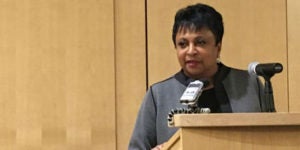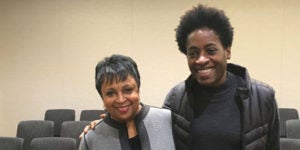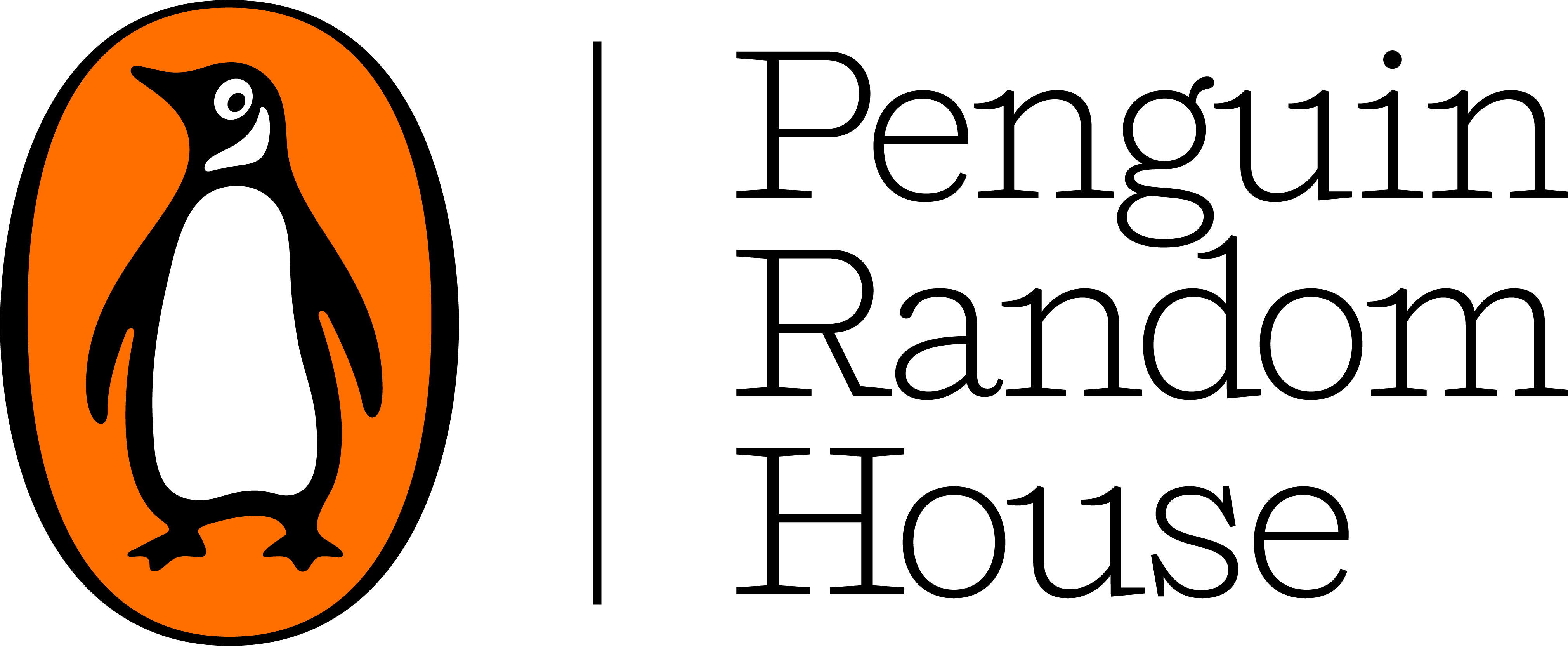Librarian of Congress Carla Hayden Visits Penguin Random House to Talk Books, Diversity and Inclusion
November 15, 2017
 It was an honor to welcome Dr. Carla Hayden, Librarian of Congress, to Penguin Random House for a special event presented by the Penguin Young Readers Marketing & Publicity Diversity Committee, with Penguin Young Readers Brand Coordinator Chloe Goodhart producing, at 345 Hudson Street on
It was an honor to welcome Dr. Carla Hayden, Librarian of Congress, to Penguin Random House for a special event presented by the Penguin Young Readers Marketing & Publicity Diversity Committee, with Penguin Young Readers Brand Coordinator Chloe Goodhart producing, at 345 Hudson Street on
 Dr. Carla Hayden and Jacqueline Woodson[/caption]
Growing up on the South Side of Chicago, Dr. Hayden said she was raised to be “socially conscious.” Recalling when she was an 8-year-old young reader, she pointed to Marguerite De Angeli’s BRIGHT APRIL (initially published by Doubleday in 1946) as “the first book I loved … because I saw myself. It’s first time I saw a sympathetic portrayal of girls that looked like me.”
Dr. Hayden discussed her beginnings as a librarian in the Chicago Public Library system, eventually rising to the post of deputy commissioner and chief librarian. In Chicago, she was keenly aware of the absence of characters of color in children’s books and was determined to “right every wrong.”
She also taught Library & Information Science at the University of Pittsburgh. She became head of the Baltimore Library system in 1993, earning praise for her work to ensure that the city’s library system offered a broad array of services to assist citizens from all walks of life. She received Library Journal’s Librarian of the Year Award in 1995.
Amidst the unrest that occurred in Baltimore in 2015 following the arrest of Freddie Gray and his subsequent death, Dr. Hayden said, “Our branch libraries were right at the epicenter on Pennsylvania Avenue. We offered safe havens. We helped raise money. And a 2-story high mural of an African American girl reading – called ‘Penny’ after a naming contest – was protected and never defaced.”
Since shifting from the Baltimore library system to the Library of Congress in Washington, DC, she keeps asking herself, “What can I do to make a difference?” She is determined “to open up the Library of Congress’s treasure chest to all, particularly young people.”
She shared a story about 8-year-old Adam Coffey who penned a hand-written note to her requesting a Library of Congress “readers card,” which can only be issued to individuals aged 16 and older. He wrote, “I don’t want to wait eight years.” So with his parents’ permission, she arranged a visit and a tour.
In an effort to further attract interest in the Library of Congress among young readers, Dr. Hayden has been working to expand the new Youth Center – a space dedicated to such areas as comic books, graphic novels and “forensic studies” of original historical manuscripts. “The goal,” she said, “is to create space that will used and inspire a series of ‘pinch me’ moments for visitors to the center.”
Before the conclusion of the event, Ms. Goodhart shared a number of questions PRH colleagues had submitted in advance. Among them: “How is digital technology used in the Library of Congress?” Dr. Hayden responded, “We have respect for young peoples’ intellect, curiosity and digital preferences. There could be a YouTube channel where stories can be shared. We have a lot of social media content, and traveling exhibits are being planned. We’re always open to trying something new.”
Dr. Hayden reminded everyone, “Books that mirror who we are in real life mean so much. Young people need to see themselves in what they are reading. They need to be able to say, ‘OK. I’m cool, too.’ Diversity and personal identity in what we read is now more important than ever.”
Dr. Carla Hayden and Jacqueline Woodson[/caption]
Growing up on the South Side of Chicago, Dr. Hayden said she was raised to be “socially conscious.” Recalling when she was an 8-year-old young reader, she pointed to Marguerite De Angeli’s BRIGHT APRIL (initially published by Doubleday in 1946) as “the first book I loved … because I saw myself. It’s first time I saw a sympathetic portrayal of girls that looked like me.”
Dr. Hayden discussed her beginnings as a librarian in the Chicago Public Library system, eventually rising to the post of deputy commissioner and chief librarian. In Chicago, she was keenly aware of the absence of characters of color in children’s books and was determined to “right every wrong.”
She also taught Library & Information Science at the University of Pittsburgh. She became head of the Baltimore Library system in 1993, earning praise for her work to ensure that the city’s library system offered a broad array of services to assist citizens from all walks of life. She received Library Journal’s Librarian of the Year Award in 1995.
Amidst the unrest that occurred in Baltimore in 2015 following the arrest of Freddie Gray and his subsequent death, Dr. Hayden said, “Our branch libraries were right at the epicenter on Pennsylvania Avenue. We offered safe havens. We helped raise money. And a 2-story high mural of an African American girl reading – called ‘Penny’ after a naming contest – was protected and never defaced.”
Since shifting from the Baltimore library system to the Library of Congress in Washington, DC, she keeps asking herself, “What can I do to make a difference?” She is determined “to open up the Library of Congress’s treasure chest to all, particularly young people.”
She shared a story about 8-year-old Adam Coffey who penned a hand-written note to her requesting a Library of Congress “readers card,” which can only be issued to individuals aged 16 and older. He wrote, “I don’t want to wait eight years.” So with his parents’ permission, she arranged a visit and a tour.
In an effort to further attract interest in the Library of Congress among young readers, Dr. Hayden has been working to expand the new Youth Center – a space dedicated to such areas as comic books, graphic novels and “forensic studies” of original historical manuscripts. “The goal,” she said, “is to create space that will used and inspire a series of ‘pinch me’ moments for visitors to the center.”
Before the conclusion of the event, Ms. Goodhart shared a number of questions PRH colleagues had submitted in advance. Among them: “How is digital technology used in the Library of Congress?” Dr. Hayden responded, “We have respect for young peoples’ intellect, curiosity and digital preferences. There could be a YouTube channel where stories can be shared. We have a lot of social media content, and traveling exhibits are being planned. We’re always open to trying something new.”
Dr. Hayden reminded everyone, “Books that mirror who we are in real life mean so much. Young people need to see themselves in what they are reading. They need to be able to say, ‘OK. I’m cool, too.’ Diversity and personal identity in what we read is now more important than ever.” Popular Company News
PRH Acquires Wonderbly, One of the UK’s Fastest-Growing Independent Publishers and Leader in Personalized Gift Books
June 4, 2025
Acquisition Underscores Penguin Random House’s Commitment to Innovation and Growth Penguin Random House, a leading global trade book publisher, has acquired Wonderbly, one of the UK’s…
Former First Lady Michelle Obama to Publish THE LOOK With Crown Publishing Group
June 5, 2025
The Crown Publishing Group today announced THE LOOK, a new book from Michelle Obama, former First Lady of the United States, to be published November 4, 2025.…
Matthew McConaughey, Academy Award-Winning Actor and Author of GREENLIGHTS, to Publish New Book With Crown
June 26, 2025
Crown, an imprint of the Crown Publishing Group, announced the September 16 publication of POEMS & PRAYERS by Matthew McConaughey, an eternal optimist, Academy Award–winning actor,…
Legendary Thriller Author Frederick Forsyth Passes Away at 86
June 10, 2025
Frederick Forsyth, bestselling author, British RAF pilot, and journalist died on Monday, June 9, 2025. He wrote eighteen espionage thrillers including THE DAY OF THE JACKAL, THE…
Penguin Young Readers to Publish Debut Picture Book by Jalen Hurts, Philadelphia Eagles Quarterback and Super Bowl MVP
June 24, 2025
Jalen Hurts, Philadelphia Eagles quarterback and 2025 Super Bowl MVP, will publish his debut children’s picture book with Flamingo Books, an imprint of Penguin Young Readers…
PYR to Publish New Book for Tweens Inspired by the #1 NYT Bestseller, THE ANXIOUS GENERATION
May 21, 2025
Rocky Pond Books, an imprint of Penguin Young Readers, will publish a companion to social psychologist Jonathan Haidt’s #1 New York Times bestselling and culturally transformative…
Penguin Press and Penguin Random House Social Impact Team Partner to Donate THE JAILHOUSE LAWYER to Incarcerated Individuals
June 25, 2025
On July 8, Penguin Press will publish THE JAILHOUSE LAWYER by Calvin Duncan and Sophie Cull. This title is a searing and ultimately hopeful account of…
Tiny Reparations Books Celebrates Their 5th Anniversary and Publication of Tourmaline’s MARSHA
June 4, 2025
On May 22, Tiny Reparations Books celebrated two momentous occasions: the 5th anniversary of the imprint and the launch of the National bestseller MARSHA, Tourmaline’s highly anticipated biography…
Companhia das Letras Recognized in Folha De S. Paulo’s Best Brazilian Books of the 21st Century
June 9, 2025
Folha de S. Paulo, a renowned Brazilian daily newspaper founded in 1921, recently released an issue celebrating the most noteworthy Brazilian literature of the 21st century. …
